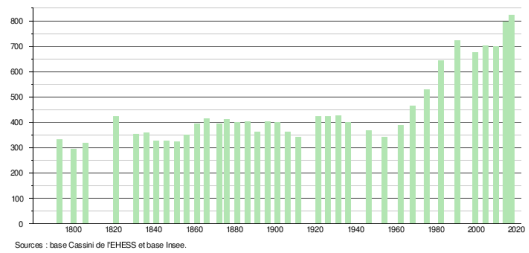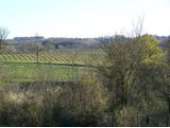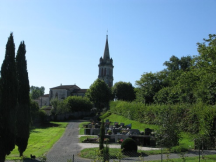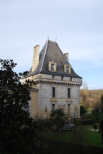Lignan-de-Bordeaux, Gironde, Nouvelle-Aquitaine 作者: 来源: 发布时间:2021-09-25
I.Population and Area
Total Area: 8, 94 km2
Population in 2017: 822
Population Density: 92 /km2
Histogram of demographic change

II.Natural Geography (environment and resources)

Lignan-de-Bordeaux is a commune in the southwest of France, located in the department of Gironde, in the Nouvelle-Aquitaine region.
Municipality of the urban area of Bordeaux and its urban unit, Lignan-de-Bordeaux is located in the natural region of Entre-deux-Mers.
The neighboring municipalities are Bonnetan to the north-north-east, Loupes to the north-east, Sadirac to the south-east, Saint-Caprais-de-Bordeaux to the south for about 175 m, Cénac to the west and Fargues-Saint-Hilaire to the northwest.
Sources :http://www.lignan-de-bordeaux.fr/index.cfm?pid=6276&p=Vues%2Dactuelles
III.ECONOMY
Employment rate (%): 81.2 (2017)
Average employment income (€):3 186 net per month (38 232 net per year)(2018)

Evolution of average monthly net wages
Sources : http://www.journaldunet.com/business/salaire/lignan-de-bordeaux/ville-33245
https://www.insee.fr/fr/statistiques/2011101?geo=COM-33245
IV.Industrial Characterisitics
The town is located in the geographical area of production of Entre-Deux-Mers (dry white wines), controlled designation of origin of the vineyard of the same name. The whole region also produces reds, clairets, rosés, dry whites, sweet or sparkling under the names bordeaux and bordeaux-superieur.
Most represented sectors of activity in Lignan-de-Bordeaux: The table below lists the five sectors of activity with the most companies in Lignan-de-Bordeaux during the period from 24/10/2019 to 24/10/2020 as well as the share of each sector on the total number of businesses in the municipality.
Sector of activity | Number of companies | Share of companies |
Rental and operation of own or leased real estate | 38 | 23.9% |
Permanent crops | 11 | 6.9% |
Activities of other membership organizations | 9 | 5.7% |
Finishing work | 6 | 3.8% |
Other personal services | 6 | 3.8% |
The companies that generate the most turnover in Lignan-de-Bordeaux: The list displayed below presents the companies established in Lignan-de-Bordeaux and which declare the highest 2019 turnover in the municipality.
S O C A P
S O C A P, limited liability company has been in business for 50 years.
Located in PAU (64000), it specializes in the field of land rental and other real estate.
Societe.com lists 1 establishment and no event.
Sources:http://entreprises.lefigaro.fr/lignan-de-bordeaux/ville-33245
https://www.societe.com/societe/s-o-c-a-p-097080378.html
V.Attractions
1. Sainte-Eulalie church

The three windows of the apse, by their architectural form, by the original cordon where a billet alternates with one or two nail heads, and by a capital inside, recall those of the apse of the Church of St. Seurin d'Artigues-près-Bordeaux and allow us to infer the presence of a team of craftsmen common to these two churches.
A. The south-eastern window of the apse:
The two capitals, with animal decoration, were mutilated, at an undetermined time, by leveling the internal face. The astragalus of the oriental capital is finely corded, unlike its opposite which is smooth, which suggests that there may have been reuse, the current position not being the original one.
The Western basket is too ruined to give an interpretation. We see a wing spread diagonally belonging to a group of two birds facing at the angle.
On the eastern basket, a dragon swallows its tail. The beast covers the whole of the uncut face. She has an interlocking spiral-scale body and a wolf's head nibbling her own tail. The other side of the basket, leveled with a saw, preserves the imprint of an animal, with at least three legs, facing the dragon. We find the same theme inside the church where a snake sucking its tail is confronted by a horse.
B. The axial window of the apse
The two baskets of the axial window bear a vegetal decoration. The capitals appear to be 19th century restorations.
C. The north-eastern window of the apse
Since the sacristy was attached to the north apsidiole, this window has been located inside the sacristy. The two capitals are covered with a thick white wash, which makes it difficult to read. The eastern capital is an interlacing of branches. On the western capital, we can distinguish leaves and croisettes; on each face, a creature which turns its head towards the angle where is a suspended object. It is not possible to decide whether the sculpture is a positive evocation (birds and fruit of Life), or an evocation of a sacrilegious Eucharist. Both types of representation are found inside the church.
The sanctuary
The apse is decorated internally with an arcade on coupled columns. The windows are splayed inside; outside, they are stepped, with a pair of small columns.
The five arches are supported by five capitals with a vegetal decoration and a single figurative, where birds drink from the same chalice, the southern capital of the axial window (c).
During soundings, a seventh capital has been discovered, suggesting that the initial arcature must also occupy the north and south walls of the apse.
The choir
We note that the pelletized cap of each capital, extended as a wall band around the apse, is identical to that seen at the Saint-Seurin church in Artigues-près-Bordeaux. Each basket is symmetrically cut and the decor naturalist in the conventional style of the second half of the 12th century.
2.The Château de Lislefort

The Château de Lislefort is a castle located in Lignan-de-Bordeaux, in Gironde.
The castle was owned by the Blanchy family.
The monument has been registered as a historic monument since December 31, 1996.
3.Chateau l'isle-Fort
It is a real Renaissance gem nestled in the heart of limestone valleys, woods and small lakes designed for fishing.
The walls of the property hosted King Henry IV.
The first traces of this property date from 1540.
At that time, a tower would have been erected on this place for purposes of military surveillance.
This 16th century fortified house was remodeled in 1608 according to an architecture characteristic of constructions from the beginning of this century.
Little by little, enlargements were added to the military tower aimed at making this privileged place a residence.
The construction was mutilated in the 19th century with the removal of the drawbridge, the enclosure and the poultry yard.
Léo Drouyn left a drawing of the entrance to the castle (private entrance not currently visible).
In the 19th century, a neo-Gothic style chapel joined the whole building. The moats full of water give the building a romanticism that does not leave indifferent.
4.Seguin Castle
It is built on the foundations of a castle belonging to a Carolingian count who is said to have been named Seguin. It is a castle which suffered from the Norman invasion.
It was destroyed and then rebuilt in the 18th century.
It was modified in the 19th century.
Part of the old castle and the 19th century castle happily coexist around a "u" shaped courtyard.
It is a charming residence.
This wine estate belonged to the Carl family from 1973 to 2003. Since February 2003 the Château de Seguin is the property of the Mottet family.
The chateau can be rented (530 m², 6 bedrooms).
Next year (2017), a 300 m² reception hall will accommodate all types of events.
5.Chateau Le Grand Verdus
The history of this castle would begin in the 16th century (1579) during the Renaissance.
It was fortified from its creation.
An old building existed on this site but it was destroyed during the Revolution.
The current castle is the subject of a fine restoration. Presence of mullioned windows, hooked tiles, dry hips, the whole of which recalls a strong Périgord influence.
The ponds present near the castle ensured the drainage of the vines. Very old terracotta pipes have been found in the vines.
It is still a beautiful building, imposing and majestic to this day.
In 1810 the Le Grix de la Salle family acquired it and transformed the property into a wine estate.
In 1974 the castle was listed as a Historic Monument in the additional inventory.
Sources : http://www.lignan-de-bordeaux.fr/index.cfm?pid=6285&p=Ch%E2teaux
VI.History
Since prehistoric times, the site has been occupied by humans, as evidenced by the discovery of Palaeolithic tools in the village, in the cave of Carles and on the localities of Nadau, Mondet and Avansay. From this period, the remains of a pottery site in Cavaillac and three kilns in the village have been unearthed, proving the existence of artisanal ceramic production on the site. Third-century coins were found on a paved path near the remains of a bridge over the Canterane, near the Chemin des Caminasses which led to Burdigala.
In the Middle Ages, monasteries appeared: that of Clos Saint Jean under the aegis of the Benedictine abbeys of La Sauve and of Sainte Croix, then that of La Ligne with the Hospitallers of Saint John of Jerusalem. It was these monks who built the Church of Sainte Eulalie, in the 12th and 13th centuries. At that time, the church of Lignan had the right of baptism, marriage and burial for the entire region: this explains the presence of monolithic tombs and numerous sarcophagi around the church; the current village square and the surrounding area of the cemetery served as a necropolis until the 15th century.
With the abbeys mentioned above, the lords share the many mills on the Pimpine, the Carles and the Canterane as well as the parish lands occupied by forests, cereals and vines. In 1453, the lord of Chapelas became co-lord with the king of the parish of Lignan and of the lands of La Ligne and Mondet; the eminent family of Pontac-Chapelas will have the right to bench and liter. The funeral urn of Uncle Arnaud de Pontac, Bishop of Bazas who died in 1605, will be placed in the crypt of the church. The owners of Isle-Fort, Seguin, Pugerin, Sentout, noble houses, often have a legal office in the Parliament of Bordeaux. Maurice de Sentout will even have the right to create a royal earthenware factory on his estate.
The Revolution brought about a new distribution of large estates. The first meeting of the municipal council took place in the church on December 27, 1792 and the parish of Sainte Eulalie would become Lignan-de-Créon. In 1847 the Saignes6 establishments were founded, a factory of fifty workers which until 1934 manufactured animal-drawn sprayers and sulfur machines for the treatment of vines. In 1873, the first section of the Bordeaux-Eymet railway line was inaugurated to transport stone from the quarries of Lignan, Cénac and other communes of Entre-deux-Mers necessary for the construction of Bordeaux buildings (in Lignan, the quarries will subsequently become mushroom farms). Four years later, 60,000 tonnes of stone were transported to Bordeaux by train and the traffic reached 8,000 travelers at Lignan station.
Around 1900, the phylloxera crisis will ruin the owners of the large wine estates. The railway line was then an asset for the businessman G.- F. Bertrin from Sainte-Bazeille8, holder of a solid fortune which would turn Lignan's life upside down in a few years: he bought the castle Seguin, founded in 1913 a pig farm of three hundred award-winning animals throughout France, a herd of a hundred dairy cows, a stud of racehorses and replanted a vineyard of one hundred and ten hectares which would produce nearly four thousand barrels of wine.
In the 1930s, one finds in Lignan (which is now called Lignan-de-Bordeaux) blacksmiths, wheelwrights, a blacksmith, a sawmill, three bars-restaurants, an inn, three grocery stores and the Zuera mill which employs about twenty workers. The school, built in 1877, was to be extended. Today, Lignan is a dormitory village, with most Lignanais working in the greater Bordeaux area. The Saignes factory has given way to a parking lot. The railway line has been converted into a cycle path appreciated by Bordeaux residents for its rural setting, the “Roger-Lapébie greenway”. The station has become the rural multiple "Le Bistrot de la Pimpine". But you can still see the remains of the past in the museum. The châteaux present their white, rosé and red wines for tasting.
VII.Other information
Community of Communes of the Portes de l'Entre Deux Mers and the Entre-Deux-Mers Heart Country
Community of Communes of the Portes de l'Entre-deux-Mers
51 chemin du port de l'homme - BP44
33360 Latresne
Phone. : 05 56 20 83 60.
mail: accueil@cdc-portesentredeuxmers.fr
site: http://www.cdc-portesentredeuxmers.fr/
The community of municipalities of the Doors of Entre-deux-Mers
It brings together 11 municipalities which are (in alphabetical order):
Baurech, Cambes, Camblanes-et-Meynac, Cénac, Langoiran, Latresne, Le Tourne, Lignan de Bordeaux, Quinsac, Saint Caprais de Bordeaux and Tabanac.
Your representatives at the C.D.C. of the Doors of Entre-deux-Mers
Pierre Buisseret and Valérie Champarnaud
The C.D.C. of the Doors of Entre-deux-Mers
You will find information about the members of the office, the administrative and technical teams and the partners here
Country Heart Entre-deux-Mers
The Heart Entre-deux-Mers is the place of cooperation of several communities of communes of Entre-deux-Mers, which have come together to work together in a spirit of solidarity, coherence and mutualisation.
The website of the Coeur Entre-deux mers country is: www.coeurentre2mers.com
Mixed Union of the Country Heart Entre-deux-Mers
20 bis Grand Rue
33760 TARGON
Phone: 05.56.23.95.17
Fax: 05.57.34.56.00
Green waste - Recycling center - Household waste
SEMOCTOM collection of household waste
Collection of household waste in brown lidded containers: Friday morning.
Collection of selective sorting in containers with yellow lids: Tuesday of every odd-numbered week.
Sorting instructions:
plastic bottles and flasks,
metal boxes,
food bricks,
cardboard boxes, newspapers, magazines, papers.
Do not put in the yellow lid container:
clothes and shoes
soiled cardboard or paper
glass bottles
If in doubt, throw your waste in your usual trash because you risk contaminating your sorting and increasing the cost of processing sorted packaging.
Green waste
For the record, the incineration of green waste is prohibited.
The municipality of Lignan de Bordeaux is located within the Protection of the Atmosphere perimeter of the Bordeaux agglomeration.
The prefectural circular of February 26, 2013, supplemented by that of June 29, 2016, manages the principles relating to the possibilities of incineration. This circular, for our area, prohibits "all year round the practice of open air burning by individuals and professionals".
Do you know the consequences of burning green waste?
This brochure will help you answer this question!
You can either compost your green waste either drop them off in the Saint Caprais, Tresses or Saint Léon waste collection centers
SEMOCTOM recycling center
Access to the recycling center is only possible by QR code (the SEMOCODE)
SEMOCTOM website
SEMOCODE flyer
Facebook SEMOCTOM
In Saint Caprais de Bordeaux: Z.A. Le Limancet 33880 Saint Caprais. Phone: 05 56 30 65 16
Open every day (Monday to Saturday) except public holidays from 9.15 a.m. to 1 p.m. and from 1.40 p.m. to 5 p.m.
A Tresses: 9 allée Newton, 33370 Tresses. Phone: 05 56 21 19 79
Open every day (Monday to Saturday) except public holidays from 9.15 a.m. to 1 p.m. and from 1.40 p.m. to 5 p.m.
Sources: http://www.lignan-de-bordeaux.fr/index.cfm?pid=6916&p=C%2ED%2EC%2E%2Det%2DPays
VIII.Contact information
Lignan de Bordeaux town hall address :
43 route de l'Entre Deux Mers
33360 Lignan de Bordeaux
France
Mayor : Pierre BUISSERET
Mail: mairie.lignan.bordeaux@wanadoo.fr
Phone number: 05 56 21 23 59
Fax: 05 56 21 22 86
Website : http://www.lignan-de-bordeaux.fr/
Sources : https://www.google.com/search?q=maire+Lignan-de-Bordeaux&oq=maire+Lignan-de-Bordeaux&aqs=chrome..69i57j0i7i30.5963j0j7&sourceid=chrome&ie=UTF-8
http://www.lignan-de-bordeaux.fr/
